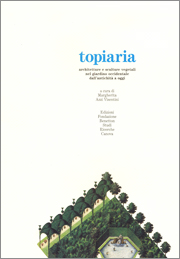
Topiaria
Architetture e sculture vegetali nel giardino occidentale dall'antichità a oggi
edited by Margherita Azzi Visentini
Fondazione Benetton Studi Ricerche-Canova
Treviso 2004
XIV-270 pages
155 illustrations in colour and 60 black and white
cover price 36 euros
ISBN 88-8409-114-4
(Memorie, 10)
[Topiaria. Sculptural and architectural vegetation in Western gardens from Antiquity to the present day]
This book fills a surprising gap in the intense coverage of almost every aspect of Western gardens over the last few years. It deals with the manipulation of plants as a plastic material to compose architectural and ornamental features, to punctuate and decorate open spaces and therefore to create gardens and treats the subject as a scientific and artistic area worthy of careful research into its origins and development and of serious critical comment. Scholars of various extractions, training backgrounds and interests, philologists and art historians, architects and landscape experts specialized in managing existing landscapes and designing new ones, literary figures, philosophers, historians of ideas, sociologists, all those, in short, whose experience and skills combine to create gardens, examine the entire chronological period from Antiquity to the present day in a representative geographical area of the Mediterranean and Western world.
Some of the contributions open new lines of interpretation, also via investigations into the origin and meaning of Latin terms derived from Greek. Since Roman times, Opus topiarium, topiaria, and topiarius have had two senses. One, a restrictive meaning, limited to the actions performed on the plants by the gardener; the other a broader concept in which topiarius means the person who creates topia, places, gardens, both painted and real; topia also implies especially important sites that may be concrete or fictional or fantastic and which employ all available means to achieve their effect: sculpture, painting, painted backdrops, buildings and the infinite variety of shapes and patterns that vegetation can provide.
On the one hand, gardens over the last two millennia, throughout the Western world, have rarely shunned the opportunity to surprise and impress, with bizarre creations and snobbish acrobacies that on occasion became expressions of virtuoso skill for its own sake, diatribe, fashion, passion, in which topiary constitutes a curious and largely unresearched facet of the history of taste. On the other hand, as the thoughtful and painstaking contributions to this volume show, topiary is also understood in its wider sense, connoting the manipulation and, by extension, the use of vegetation. Plant shapes in fact provide the basis of the structural and ornamental features (espaliers, pergolas, pavilions, hedges, flower beds and borders and various other compositions) that have been combined to give gardens shape, character and decorative definition over the years. In this sense, topiary cannot (and must not) be allowed to decline. On the contrary, there are abundant prospects for its continued practice and application in unexpected fields.
The book explores the various aspects of topiary – ideas and skills, science and technique, trades and crafts – in the main European countries and includes an examination of the problems associated with the maintenance of the fragile structures and sculptures fashioned from plants. This is a collective effort that seeks not to settle matters but rather to rekindle discussion and stimulate research into a subject that has been considered marginal, “not really serious”, shunned by academe, the preserve of buffs and fanatics. What the book shows is that topiary is in fact rich, complex and fundamental to the history and the geography of gardens and gardening.
Contents
Margherita Azzi Visentini, Introduzione, VII
Paolo Cottini, Le origini. Rilettura delle fonti e ipotesi interpretative, 1
Alessandro Viscogliosi, Topiaria: un’altra proposta di lettura nel mondo romano, 16
José Tito Rojo e Manuel Casares Porcel, L’arte topiaria nei giardini spagnoli di tradizione araba, 22
Monique Mosser, Enjeux et débats autour de l’art topiaire dans l’histoire des jardins en France, 33
Clemens Alexander Wimmer, Topiary in Germany, 50
Erik A. De Jong, Graceful ornament or formal mockery? Dutch topiary between taste and trend, 57
David Jacques, English Renaissance and Baroque Topiary, 71
Margherita Azzi Visentini, Architetture e sculture vegetali nei giardini italiani tra Trecento e Settecento. Fonti iconografiche e letterarie, 81
Giorgio Galletti, Fortune e sfortune del bosso nei giardini italiani dal Rinascimento al Novecento, 93
Lucia Tongiorgi Tomasi, Tradizione iconografica, simbologia e scienza in alcuni progetti di arte topiaria tra Cinquecento e Seicento, 104
Litta Maria Medri, Le architetture vegetali nelle rappresentazioni pittoriche, 114
Eraldo Antonini, «Tutte le siepi d’ogni sorta di animali». L’arte topiaria nei giardini estensi (XVII-XIX secolo), 124
Giuseppe Rallo, Labirinti: artifici d’arte topiaria, 136
Paola Lanzara, La siepe, 153
Patrizio Giulini, La botanica e l’arte topiaria, 163
Elena Accati e Marco Devecchi, Conoscenza e gestione delle architetture vegetali. La componente botanica, 175
Vincenzo Cazzato, Il giardino italiano e le sue geometrie nella storiografia e in alcune realizzazioni del primo Novecento, 186
Maria Adriana Giusti, La conservazione della scena verde: il difficile equilibrio di un artificio topiario, 196
Domenico Luciani, Arte topiaria nel paesaggismo contemporaneo, 205
Margherita Lombardi, Attualità dell’arte topiaria, 212
Cristiana Serra Zanetti, Le piante dell’arte topiaria. Le specie e la loro biologia, 220
Elizabeth Braimbridge, Boxwood. The plant of many surprises, 226
Bibliografia citata, 231
Riassunti/Abstracts, 247
Indice dei nomi e dei luoghi, 257
Referenze sulle illustrazioni, 268
